 in comparision with Raytracing simulations
in comparision with Raytracing simulations in comparision with Raytracing simulations
in comparision with Raytracing simulations
Cloud effects |
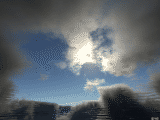
Raytracing of a backlit cloud |
|
| As stated in the Terrestrian tour, clouds might contain very colorful regions, especcially when diffraction effects come into account. The most prominent effect are the icebows, but even `normal' clouds may appear in other colors than in mere white when they are viewed at an small angle relative to the sun. |

| |
| This effect is visible on these photographs, taken on a very cold day in the December of 1996, temperatures even in the valleys where about -10°C. Therefore in the height of the clouds the water surely was ice, which is a good condition for the creation of colorful diffraction effects. While the colors were visible with the naked eye also (though one usually does not look at such bright backlit clouds nearby the sun and therefore such appearance normally is overseen), the colors come out even clearer in this contrast enhanced version. |

| |
| It's mainly the lower left part of this cloud complex and the small cloud on the left edge, which shows the most prominent color fluctuations. This zoomed image is even more contrast enhanced to evidently demonstrate the color of the clouds. It is worth to take a look to real clouds in nature to spectate this effect! |

| |
|
Mountain regions |
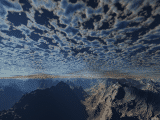
Raytracing of a mountain area |
|
| The valley of the river Inn covered by a dense cloud layer, as seen on a winter day from the Hafelekar at an height of 2300m over sea level. The city of Innsbruck is beyond the inversion layer, whose upper limit reaches about 1000m. This photograph also nicely demonstrates the effect of high forward scattering in the upper stratospheric cloud layer. |
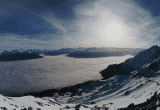
| |
| At the same time as in the former photography, looking into the west direction this image demonstrates that the backward reflectivity of clouds, i.e. the inversion layer, is significantly lower as snow, due to the greate forward scattering property. While snow reflectes light relatively well diffuse into all directions, clouds reflect more light forwads than backwards, therefore they appear dim grey in comparison with the surrounding snow covered mountains. |
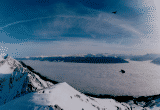
| |
|
The Starry Nightsky |
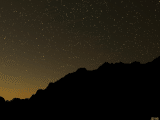
Raytracing of the starry night sky While stars pass away during the photographic exposure, in the simulation they can be hold on place. |
|
| This image was taken on a clear, moonless night from a position near Innsbruck along the Wipptal in south-west direction. Exposure time was half an hour on a 25 ASA film. The light on the horizon supposedly comes from the big cities in northen Italy, about 200km away from the observing position! |
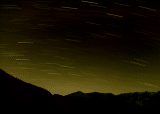
| |